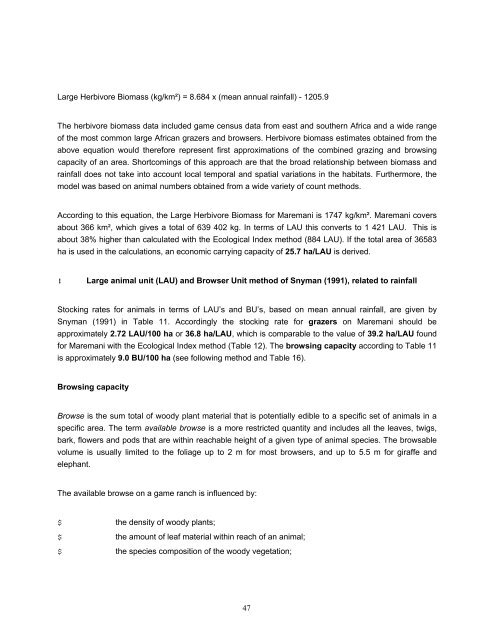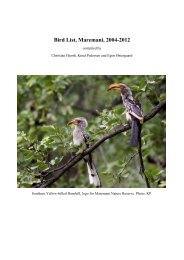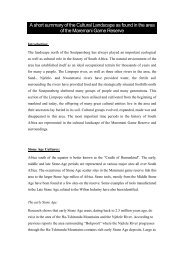the vegetation types and veld condition - Maremani Nature Reserve
the vegetation types and veld condition - Maremani Nature Reserve
the vegetation types and veld condition - Maremani Nature Reserve
Create successful ePaper yourself
Turn your PDF publications into a flip-book with our unique Google optimized e-Paper software.
Large Herbivore Biomass (kg/km²) = 8.684 x (mean annual rainfall) - 1205.9<br />
The herbivore biomass data included game census data from east <strong>and</strong> sou<strong>the</strong>rn Africa <strong>and</strong> a wide range<br />
of <strong>the</strong> most common large African grazers <strong>and</strong> browsers. Herbivore biomass estimates obtained from <strong>the</strong><br />
above equation would <strong>the</strong>refore represent first approximations of <strong>the</strong> combined grazing <strong>and</strong> browsing<br />
capacity of an area. Shortcomings of this approach are that <strong>the</strong> broad relationship between biomass <strong>and</strong><br />
rainfall does not take into account local temporal <strong>and</strong> spatial variations in <strong>the</strong> habitats. Fur<strong>the</strong>rmore, <strong>the</strong><br />
model was based on animal numbers obtained from a wide variety of count methods.<br />
According to this equation, <strong>the</strong> Large Herbivore Biomass for <strong>Maremani</strong> is 1747 kg/km². <strong>Maremani</strong> covers<br />
about 366 km², which gives a total of 639 402 kg. In terms of LAU this converts to 1 421 LAU. This is<br />
about 38% higher than calculated with <strong>the</strong> Ecological Index method (884 LAU). If <strong>the</strong> total area of 36583<br />
ha is used in <strong>the</strong> calculations, an economic carrying capacity of 25.7 ha/LAU is derived.<br />
! Large animal unit (LAU) <strong>and</strong> Browser Unit method of Snyman (1991), related to rainfall<br />
Stocking rates for animals in terms of LAU’s <strong>and</strong> BU’s, based on mean annual rainfall, are given by<br />
Snyman (1991) in Table 11. Accordingly <strong>the</strong> stocking rate for grazers on <strong>Maremani</strong> should be<br />
approximately 2.72 LAU/100 ha or 36.8 ha/LAU, which is comparable to <strong>the</strong> value of 39.2 ha/LAU found<br />
for <strong>Maremani</strong> with <strong>the</strong> Ecological Index method (Table 12). The browsing capacity according to Table 11<br />
is approximately 9.0 BU/100 ha (see following method <strong>and</strong> Table 16).<br />
Browsing capacity<br />
Browse is <strong>the</strong> sum total of woody plant material that is potentially edible to a specific set of animals in a<br />
specific area. The term available browse is a more restricted quantity <strong>and</strong> includes all <strong>the</strong> leaves, twigs,<br />
bark, flowers <strong>and</strong> pods that are within reachable height of a given type of animal species. The browsable<br />
volume is usually limited to <strong>the</strong> foliage up to 2 m for most browsers, <strong>and</strong> up to 5.5 m for giraffe <strong>and</strong><br />
elephant.<br />
The available browse on a game ranch is influenced by:<br />
$ <strong>the</strong> density of woody plants;<br />
$ <strong>the</strong> amount of leaf material within reach of an animal;<br />
$ <strong>the</strong> species composition of <strong>the</strong> woody <strong>vegetation</strong>;<br />
47




